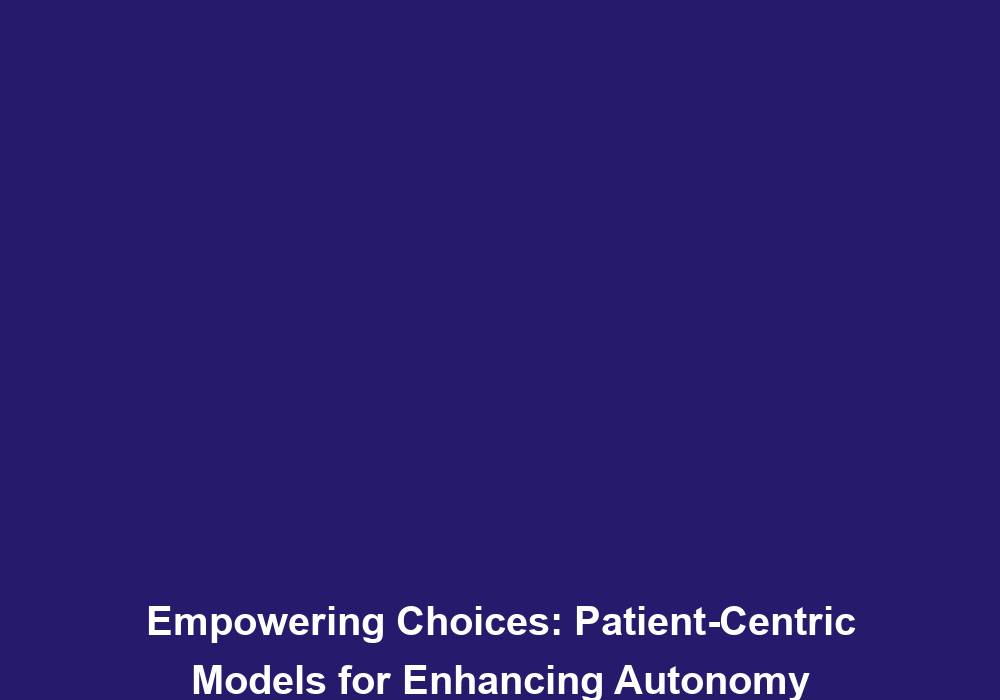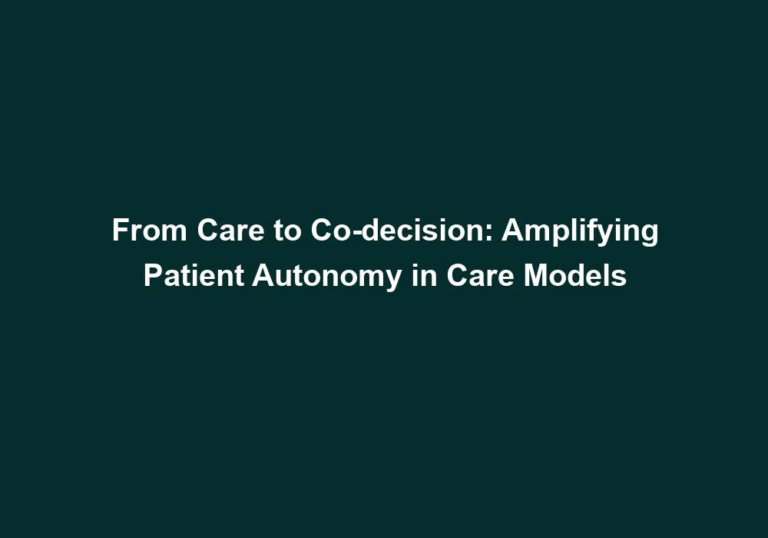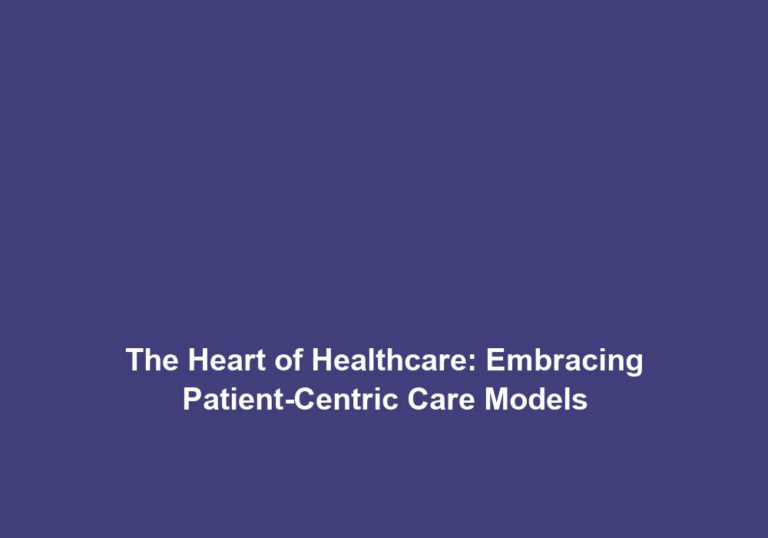Empowering Choices: Patient-Centric Models for Enhancing Autonomy
In recent years, the healthcare industry has witnessed a significant shift towards patient-centric models of care. Recognizing the importance of empowering patients and enhancing their autonomy, healthcare providers have started implementing innovative strategies to involve patients in decision-making processes and improve their overall experience. This article explores the concept of patient-centric care and discusses various models that can be adopted to empower patients and enable them to make informed choices about their healthcare journey.
Understanding Patient-Centric Care
Patient-centric care is a holistic approach that places the patient at the center of the healthcare experience. It goes beyond merely treating the illness and focuses on meeting the unique needs, preferences, and values of each individual.
Importance of Patient Engagement
By actively involving patients in their care plans, healthcare providers aim to enhance patient satisfaction, improve treatment outcomes, and ultimately promote better overall health. Patient engagement plays a crucial role in achieving these goals. When patients are actively engaged in their healthcare journey, they are more likely to adhere to treatment plans, leading to better treatment outcomes and reduced healthcare costs.
Building Trust and Communication
Patient-centric models of care also prioritize building trust and communication between healthcare providers and patients. Open and transparent communication fosters trust and builds stronger therapeutic relationships. Patients feel more comfortable discussing their concerns, asking questions, and actively participating in decision-making processes. By actively involving patients in decision-making, healthcare providers can ensure that the care provided aligns with the patient’s goals and values, leading to higher levels of satisfaction.
Personalized Care and Improved Outcomes
Patient-centric care focuses on providing personalized care that takes into account the unique needs and preferences of each patient. By understanding the individual’s background, beliefs, and values, healthcare providers can tailor their approach to ensure culturally sensitive and inclusive care. This personalized approach has been associated with improved health outcomes, including reduced hospital readmissions, quicker recovery times, and better overall quality of life.
Benefits of Patient-Centric Models
Adopting patient-centric models of care brings numerous benefits for both patients and healthcare providers. Some of these advantages include:
-
Improved Patient Satisfaction: By actively involving patients in decision-making processes, healthcare providers can ensure that the care provided aligns with the patient’s goals and values, leading to higher levels of satisfaction. Patients feel heard and valued, which enhances their overall experience.
-
Enhanced Treatment Compliance: When patients feel empowered and informed, they are more likely to adhere to treatment plans. Patient-centric models provide patients with the necessary knowledge and resources to actively participate in their own care, leading to better treatment outcomes and reduced healthcare costs.
-
Better Communication and Trust: Patient-centric models encourage open and transparent communication between healthcare providers and patients. This fosters trust and builds stronger therapeutic relationships. Patients feel more comfortable discussing their concerns and actively participating in decision-making processes.
-
Higher Engagement and Active Participation: Empowered patients are more engaged in their healthcare journey. They actively participate in shared decision-making and take responsibility for their well-being. By involving patients in the decision-making process, healthcare providers ensure that the chosen treatment plan aligns with the patient’s preferences, values, and goals.
-
Improved Health Outcomes: Patient-centric care has been associated with improved health outcomes. By addressing the unique needs and preferences of each patient, healthcare providers can deliver personalized care that leads to reduced hospital readmissions, quicker recovery times, and better overall quality of life.
Models for Enhancing Autonomy
To achieve patient-centric care and empower patients to make choices concerning their health, healthcare providers can implement various models. Here are some effective approaches:
1. Shared Decision-Making
Shared decision-making involves a collaborative partnership between healthcare providers and patients, where both parties contribute to the decision-making process. This model ensures that patients are well-informed about their condition, treatment options, risks, and benefits. It allows patients to actively participate in selecting the most appropriate treatment plan that aligns with their preferences, values, and goals.
Importance of Information Sharing
Shared decision-making relies on effective information sharing between healthcare providers and patients. Healthcare providers should ensure that patients have access to accurate, reliable, and easy-to-understand information about their condition, treatment options, and potential outcomes. This enables patients to make informed choices and actively engage in their own care.
Involving Patients in Treatment Planning
In a shared decision-making model, healthcare providers actively involve patients in the treatment planning process. This includes discussing various treatment options, explaining the potential risks and benefits of each option, and considering the patient’s preferences and goals. By involving patients in the decision-making process, healthcare providers empower them to make choices that align with their values and enhance their overall satisfaction.
Benefits of Shared Decision-Making
Shared decision-making has numerous benefits for patients. It promotes patient autonomy, allowing individuals to actively participate in decisions regarding their healthcare. This involvement leads to higher levels of satisfaction, as patients feel more in control of their own care. Shared decision-making also improves treatment compliance, as patients are more likely to adhere to treatment plans when they have been actively involved in the decision-making process.
2. Patient Education and Health Literacy
Promoting health literacy and providing comprehensive patient education materials are crucial elements of patient-centric care. Healthcare providers should ensure that patients have access to accurate, reliable, and easy-to-understand information about their condition, treatment options, and self-management strategies.
Importance of Health Literacy
Health literacy plays a significant role in empowering patients to make informed choices about their health. When patients have a good understanding of their condition, treatment options, and self-management strategies, they can actively participate in their own care and make decisions that align with their preferences and goals. Healthcare providers should prioritize health literacy by providing clear and concise information that is tailored to the individual patient’s needs.
Comprehensive Patient Education
Patient-centric models of care emphasize the importance of comprehensive patient education. Healthcare providers should provide patients with educational materials that are easy to understand and accessible. These materials should cover various aspects of the patient’s condition, including symptoms, treatment options, potential risks and benefits, and self-management strategies. By providing patients with accurate and reliable information, healthcare providers empower them to make informed choices and actively engage in their own care.
Utilizing Technology for Patient Education
Technology can greatly enhance patient education and health literacy. Healthcare providers can leverage digital platforms, such as patient portals and mobile applications, to provide patients with educational resources and tools. These platforms can offer interactive features, such as videos, infographics, and quizzes, to engage patients and facilitate their understanding of complex medical concepts. By utilizing technology, healthcare providers can ensure that patients have access to educational materials whenever and wherever they need them.
3. Technology-Enabled Care
Leveraging technology can significantly enhance patient autonomy and engagement. Telehealth services, mobile applications, and patient portals facilitate remote consultations, access to medical records, appointment scheduling, and medication reminders. These tools provide patients with greater control over their healthcare journey, enabling them to access care conveniently and stay actively involved in their treatment plans.
Benefits of Telehealth Services
Telehealth services have revolutionized the way healthcare is delivered. They allow patients to consult with healthcare providers remotely, eliminating the need for in-person visits. This improves access to care, particularly for patients who may have limited mobility or live in remote areas. Telehealth services also enable patients to actively participate in their own care by providing them with convenient and timely access to healthcare professionals.
Mobile Applications for Patient Engagement
Mobile applications offer patients a range of features that promote engagement and self-management. These applications can provide patients with personalized care plans, medication reminders, symptom tracking tools, and access to educational resources. By utilizing mobile applications, healthcare providers empower patients to actively participate in their own care and make informed choices about their health.
Patient Portals for Access to Information
Patient portals are secure online platforms that allow patients to access their medical records, test results, and appointment schedules. These portals provide patients with the ability to review their health information, ask questions, and communicate with their healthcare providers. By utilizing patient portals, healthcare providers enable patients to take control of their healthcare journey, access information conveniently, and actively engage in their own care.
4. Patient Advocacy and Support
Patient advocacy programs aim to support and empower patients throughout their healthcare journey. These programs provide guidance, emotional support, and resources to help patients navigate the complexities of the healthcare system.
Role of Patient Advocates
Patient advocates play a crucial role in supporting patients and ensuring their voices are heard. They provide guidance and assistance to patients, helping them navigate the healthcare system, understand their rights, and make informed decisions. Patient advocates also serve as a bridge between patients and healthcare providers, facilitating communication and ensuring that patients’ concerns are addressed.
Benefits of Patient Advocacy Programs
Patient advocacy programs have numerous benefits for patients. They provide emotional support and reassurance during challenging times, helping patients cope with their conditions and navigate the healthcare system more effectively. Patient advocates also empower patients by educating them about their rights, treatment options, and available resources. By having access to patient advocates, patients can confidently voice their concerns, seek clarification, and actively participate in decision-making processes.
Empowering Patients Through Support Groups
Support groups are another important component of patient-centric care. They bring together individuals with similar conditions or experiences, allowing them to share their stories, seek advice, and provide emotional support to one another. Support groups empower patients by creating a sense of community and providing a platform for shared experiences and learning.
5. Cultural Sensitivity and Diversity
Recognizing and respecting the unique cultural backgrounds, beliefs, and values of patients is crucial in patient-centric care. Healthcare providers should strive to create an inclusive and culturally sensitive environment that caters to the diverse needs and preferences of patients.
Importance of Cultural Sensitivity
Cultural sensitivity ensures that healthcare providers understand and respect the cultural beliefs and practices of their patients. This understanding allows healthcare providers to deliver care that is aligned with the patient’s cultural values and preferences. By embracing cultural sensitivity, healthcare providers foster trust, improve communication, and enhance patient autonomy.
Multilingual Services and Interpreters
To ensure effective communication and understanding, healthcare providers should offer multilingual services and access to interpreters. This ensures that patients who do not speak the dominant language can effectively communicate their needs, concerns, and preferences. By providing language support, healthcare providers eliminate language barriers and empower patients to actively participate in their own care.
Tailoring Care to Cultural Needs
Patient-centric care requires healthcare providers to tailor their approach to meet the unique cultural needs of each patient. This may include considerations such as dietary restrictions, religious practices, and traditional healing methods. By acknowledging and respecting these cultural factors, healthcare providers can deliver care that is sensitive to the individual patient’s preferences and values.
Conclusion
Patient-centric models of care are transforming the healthcare landscape by prioritizing patient empowerment and autonomy. By adopting shared decision-making, promoting health literacy, leveraging technology, providing patient advocacy, and embracing cultural sensitivity, healthcare providers can empower patients to take an active role in their care. These models not only improve patient satisfaction and treatment outcomes but also contribute to a more patient-centered healthcare system. Embracing patient-centric care is a crucial step towards delivering high-quality, personalized healthcare experiences that prioritize the needs and choices of every individual.






